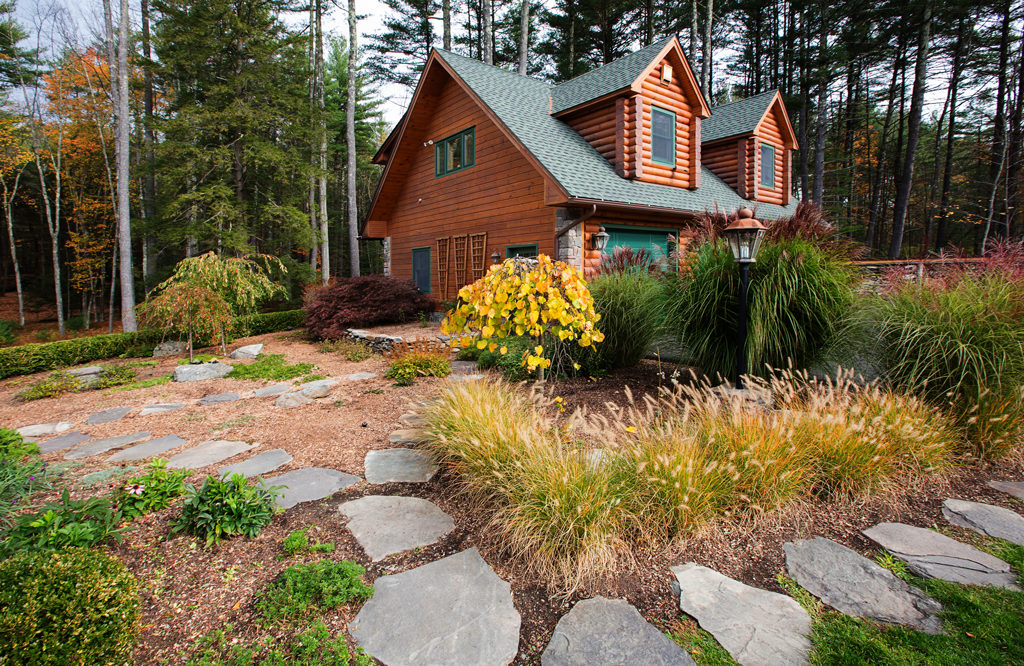
Most people agree that the key to achieving curb appeal is a thoughtfully designed, well-maintained landscape. That’s why “decorating” the outside of your home can be just as important as decorating the inside.
Your landscaping can get creative and still be simple and easy to maintain. In fact, that’s what we recommend. In today’s busy life, few people have hours and hours for maintaining their landscape. First, stop thinking in urban terms. For instance, don’t limit yourself to manicured garden beds around your cabin’s footings. Go natural and save the manicured, formal look for a city house. Consider the use of native plants or plants that look like they are native to your area. Use flat boulders instead of manufactured steps or stones. Try and make use of the natural beauty of the area and blend it into your landscaping design.
Below is a list of several landscaping tips that will help you achieve and easily maintain your homes curb appeal.
But first, a few safety tips!
Before you do anything, have any underground utilities marked by your local officials so you don’t accidentally dig into buried wires and pipes. Check the mature height and width of the trees or shrubs you want to plant. You don’t want them to grow into your cabin or overhead power lines. A big mistake people make s planting to close to their home. It’s a good rule of thumb to not plan within 18” of your home’s exterior.
LANDSCAPING TIPS
- Avoid using lots of beds and borders that need weeding and edging. The additional effort they require can add hours to your landscaping maintenance regimen.
- In areas where you have planting beds, use a generous amount of mulch to keep weeds at bay and reduce the amount of time you spend watering. Laying down landscaping paper can also aid with weed issues. Consider organic mulch as it adds nutrients to the soil and conserves moisture. Remember to keep mulch at least 2 feet from your home, as it does tend to attract varmints.
- If you decide to go with a few flower beds, keep them narrow enough so that you can reach across easily, but not so narrow that plants continually outgrow their bounds.
- Ever heard of the team Streamline Garden? This method works by grouping plants together according to their treatment requirements. It’s easier to fertilize plants that are all in one place, rather than scattered throughout the property.
- Replace grass with ground covers. Ground covers are a key ingredient to no-sweat landscaping. Most ground covers need little or no maintenance once they’re established. As for weeding, a healthy, densely growing ground cover should choke out all but the most persistent weeds, and those that remain will be spindly and weak.
- Use hardscapes creatively. Hardscapes, the landscaper’s term for paving and building features in a garden (think patios and walkways) reduce garden work and extend your home’s living space. Although more expensive at the onset, hardscapes are virtually maintenance- and cost-free once they’re in place. One idea is instead of planting grass against walls or fences, install a hard-surface border around the edge at ground level. This will make trimming and cutting grass go much faster.
- Plant flowering shrubs for color and texture. Shrubs require less care than annuals and perennials. A variety of shrubs produce attractive in-season blossoms, providing the color you want without the higher maintenance of flowers.
- Plant perennials. The beauty of perennials is that they pop up each year with little or no effort on your part. Some perennials can be demanding, however, so choose wisely.
- A flat landscape can be a bit boring. Consider building a berm with good topsoil and several levels, often setting boulders inside them so the ground is not completely level can add character. Adding 3-D to your landscaping will give it a more rural feel and allow you to layer short, medium, and tall plants together for an exciting look!
EDUCATIONAL TIPS
- Know your hardiness zone. Before you buy, check plant tags to be sure your selections can survive local conditions. Consult the USDA’s Plant Hardiness Zone Map if you don’t know your zone. Searching “hardiness zone” yields the map and helpful articles, including one on fire-resistant plants.
- Check for sunlight. If your cabin is parked in deep shade, don’t expect full-sun plants to grow there, and vice versa.
- Consider maintenance. No landscape is completely without maintenance, so save time by planting native perennials, shrubs, and trees that don’t require supplemental watering and primping.
Most importantly, enjoy your landscaping project. Make it a family event by having the kids and rest of the family join in. There is nothing like gardening to help you feel a little closer to nature.








